Ever since the first Maxim designs, silencer makers have focused on one thing: containment. The sound of gunfire is caused by the rapid expansion of super-heated gasses escaping as the bullet leaves the barrel. Think of a cork exiting a champagne bottle. Maxim’s design was simple — slow down the gasses and cool them enough and they won’t produce so much noise.
That made sense for bolt-action firearms. With the advent of semi-auto and machine guns, that containment tends to have some nasty side effects. Namely a phenomenon called “back pressure”.
On guns like the AR-15, the added pressure from the silencer forces gasses back through the barrel towards the shooter. These gasses leak out of the gun in all sorts of places, from the charging handle to the magazine well, making the shooting experience decidedly less pleasant. The same thing happens on handguns, usually sending bits of unburnt powder back into the shooter’s face.
For machine guns, though, the issue isn’t simply one of comfort. The guns are designed to function at a certain speed The so-called “cyclic rate of fire,” expressed in how many rounds per minute the firearm would shoot with an infinite ammunition supply.
As designed, the gun will happily chug along, but when you something like a silencer that adds back pressure, that increases the cyclic rate. Parts wear out faster, ammunition doesn’t last as long. In general, nothing good happens.
Ideally there should be a way to reduce the noise signature of an automatic firearm without increasing its cyclic rate or back pressure. NG2 Defense thinks they’ve found just the solution with their MAXFLO 3D suppressor.
The MAXFLO 3D’s design is different almost from the very start. Instead of a traditional baffle stack, the central core of the silencer consists of a radially vented tube much like the muzzle brakes NG2 also designs and produces.
These vents relieve the pressure that builds up behind the projectile, venting the pressure into a surrounding chamber. The benefit here is that instead of pressurizing one chamber after another as the bullet travels through the silencer, the pressure is constantly and evenly reduced.
Slotted over the tube is a wavy looking expansion chamber. The idea here is to allow the gasses some space to expand, but with enough ridges and channels that the gasses are slowed down enough that they don’t get ahead of the bullet. Those ridges also act as a heat sink, cooling the gasses and transferring the energy to the surface of the silencer.
Interesting to note: the expansion chamber doesn’t have a solid edge. It’s open on the right side there. That will come into play in a moment.
Next up for the bullet as it flies through this contraption is a solid tube. That might seem counter productive — why wouldn’t we want to keep venting off gasses into additional chambers?
The point here is to give that section of vented tube and those wavy baffles time to work. As the bullet moves through the solid tube the built-up pressure in the barrel is transferred to the expansion chamber, and as the expansion chamber pressurizes, it forces the gasses through the rest of the can.
Slotted onto that solid tube are a series of slotted screens. Four screens are used in this model, each aligned so that the slots in one are covered by the solid surface of the next.
These screens give the pressure in the expansion chamber an escape path. That does enough to slow down the gasses and give them time to cool before they get to the final exit point that they no longer create much noise when released.
When fully assembled the innards of the silencer fit into a fairly compact package. You can see the path the pressurized gasses take — from the vented tube, through the expansion chamber, and up through the screens. All that’s left is the actual exit point.
Most silencers have a single central exit point for the expanded gasses. With the MAXFLO 3D, the majority of the expanded gasses actually leave the can through a series of vents along the outside edge. This allows the gasses to vent more freely and quickly, which is critical for reducing back pressure.
The crenelated design at the forward edge of the silencer’s jacket isn’t just for show. Taking inspiration from the noise reducing exhaust ducting of the Boeing 787, the MAXFLO 3D uses the same principles to promote better and quieter mixing of the exhaust gasses with the surrounding (much cooler) ambient air.
In short, the can is designed to slowly cool and vent exhaust gasses instead of containing them. But how well does that work in practice?
Even on the end of a proper 16-inch rifle the MAXFLO 3D doesn’t feel that heavy.
I’ve shot a lot of suppressed 5.56 NATO rifles in my day. Some cans don’t work well, with enough residual noise that the gun still isn’t comfortable to shoot without ear protection.
With the MAXFLO 3D (on a 16-inch gun in an open bay) the rifle was indeed hearing safe and felt perfectly comfortable to shoot. Checked that box, for sure.
Speaking of comfort, the silencer delivered on its other promise of reduced back pressure. There was no gas being blown back in my face, which was definitely appreciated. The cyclic rate of fire didn’t really change either when the silencer was added to the front of the gun.
Using a fully automatic AR-15 we tested the difference between a standard configuration and one with the silencer attached.
The MAXFLO 3D did increase the cyclic rate, but only slightly…by about one or two rounds per minute. That’s a huge improvement over the couple of hundred rounds per minute increase typical from traditional silencer designs.
So, what’s the bottom line here? There is one competitor in this space, namely OSS Suppressors. Their 5.56 NATO version (HX 556) is roughly analogous to the MAXFLO 3D, and the two are roughly similar in terms of weight and external dimensions.
The difference, having shot both, is that the MAXFLO 3D sounds quieter to my ear. At $1,1189 MSRP it’s about $300 cheaper than the MAXFLO 3D, but it does require a somewhat interesting mounting system. The analogous direct thread OSS version is longer, heavier, requires a slim barrel, and much more expensive.
The problem comes when comparing the MAXFLO 3D to traditional designs, like the SIG SAUER SRD 5.56 which clocks in at a ridiculously low $545 MSRP. For the average shooter the traditional design works just fine, especially when it’s almost 1/3 the price of the turbine designs.
Where this design makes the most sense is when you’ll be shooting fully automatic weapons. That’s not something most shooters will do, but that’s where having lower cyclic rates is imperative to keep the gun from self destructing.
Specifications: NG2 Defense MAXFLO 3D
Mounting: 5/8 x 24 or 1/2 x 28 direct thread
Length: 7 inches
Width: 1.9 inches
Weight: 22 ounces
Caliber: .30 caliber
Price: $1,495
Ratings (out of five stars):
Fit, Finish, Build Quality: * * * *
A caveat: this is a brand new shop. Their processes and materials are top notch, and much like so many others in the industry, they cut their teeth on aerospace engineering. So while they don’t have a track record in the firearms business they show some real promise.
Sound Attenuation: * * *
Hearing safe at the shooter’s ear, even on full auto.
Overall Rating * * *
For those who are concerned about reducing back pressure and keeping your machine gun from tearing itself apart, it’s a fine choice. A little expensive, but less complicated and (in my opinion) quieter than the competition.

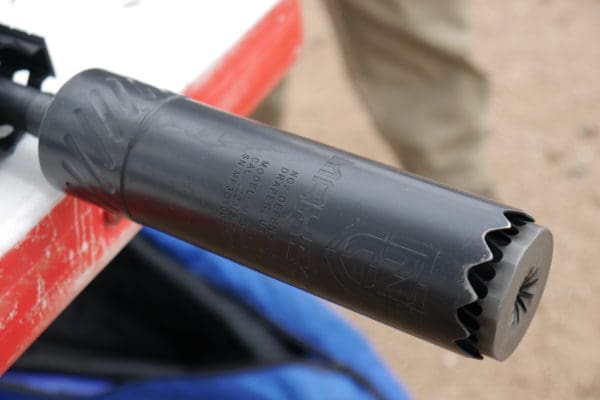
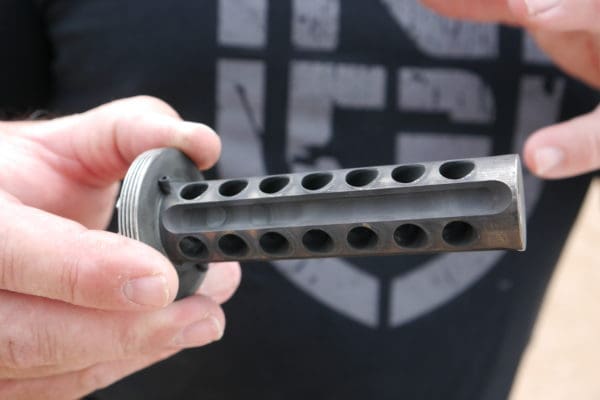
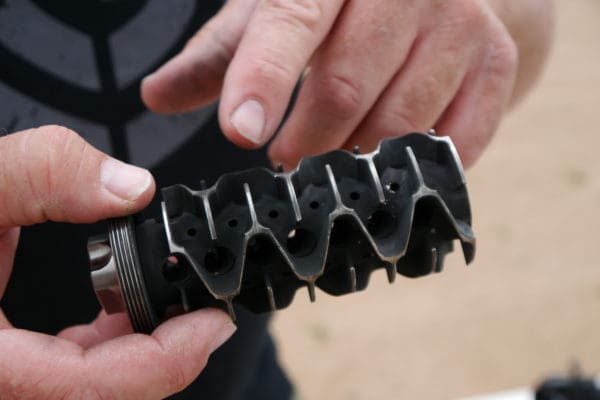
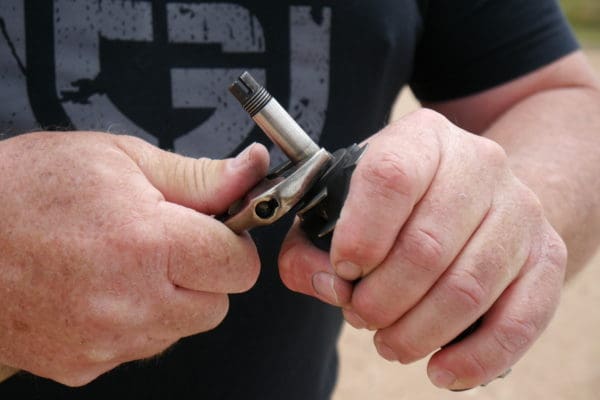
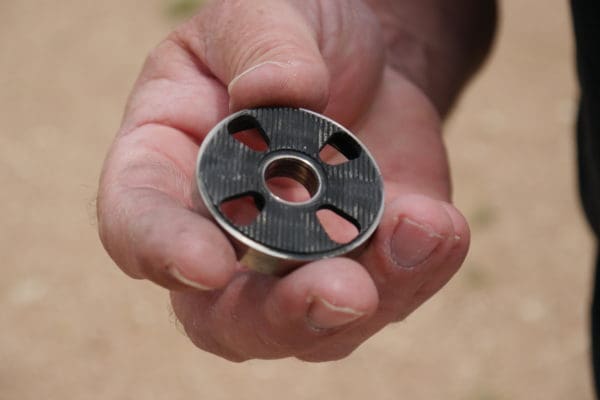
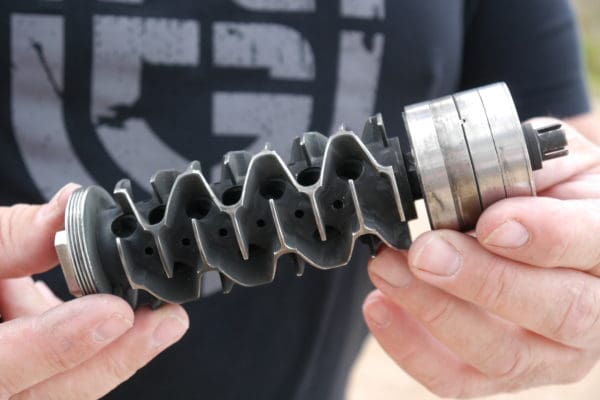
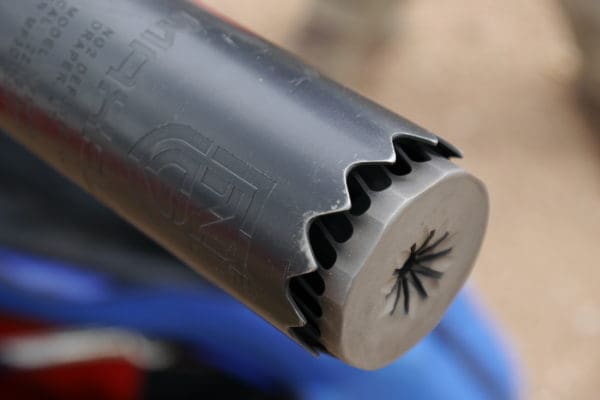
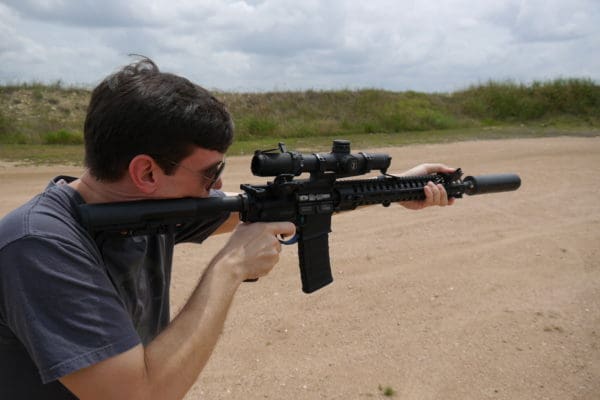
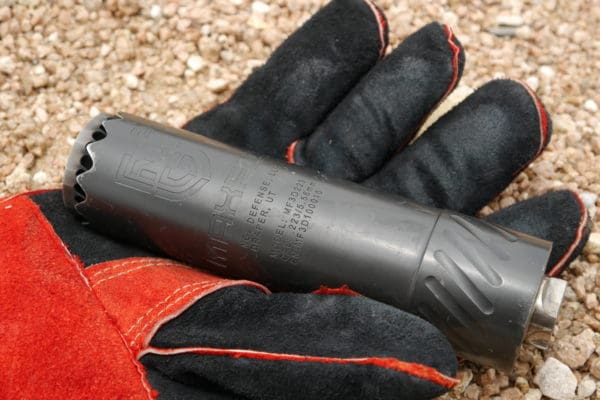



Now I got to look at getting one of these…
See also https://osssuppressors.com/
I’m guessing this is a direct thread? Slight disadvantage there for folks who own more than one gun and want to move it around frequently. But based on how it works I’m not surprised … The standard QD / brake / flash hider combo would likely mess with the intended operation.
“MAXFLO” sounds like a prostate pill.
I was thinking a new super-tampon.
Goes right along w/ that exit hole — pucker up !
It really does look disturbingly like a butthole.
Ever since I started taking FLOMAX, my pees are actually noisier than before. So maybe MAXFLO is just the opposite?
This seems to be innovative.
Even with semi auto it’s almost worth the price just in reduced cleaning issues.
I don’t get a facefull of crap from suppressing my AR but I do end up with a very messy rifle.
Reducing the amount of crap that comes back at you from a pistol would be nice too, if they can swing that.
I have a baffled suppressor and gas redirecting charging handle. I don’t know if it is the charging handle, but I also never get any gas in my face. I hardly even smell it. Not sure about how much dirtier it is because I almost always shoot suppressed now.
Mine gets dirty way, way faster but it’s not enough to cause malfunctions for a few hundred rounds. Just add some lube after that and it still runs fine.
My post cleaning pile of used patches grew enormously after I started shooting suppressed. It’s remained that way for a few years now.
A slight correction… Where this design makes the most sense is when you’ll be shooting in combat situations, e.g. high rate of fire, running through multiple magazines quickly, a critical need to keep all senses operating at full potential without interference from hot irritating gas in the face, etc. Full-auto vs semi-auto is irrelevant.
Otherwise, I’m thrilled to see other manufacturers following the lead of OSS and paying attention to backpressure! Now let’s get this one on a meter side by side with OSS (and any others available) and be sure to measure at the shooter’s ear in addition to the muzzle.
I loved what the OSS had to offer: I haven’t seen such a detailed break down of that suppressor.
This one looks great. Well thought out and beautiful engineering. I assume this was 3D printed based on the title?
Hope for the HPA because I won’t have a chance in hell of getting a suppressor unless that passes- and I think this is a genius design!
I did a little video on my OSS (Gen 4). It’s nothing professional, but might show you more than you’ve seen so far:
https://www.youtube.com/watch?v=J6CPTPyK-xI
I have never understood why suppressors are so expensive. Can someone enlighten me?
Part of it is due to the limited market since they are NFA items and a PITA to get. If they get removed from the NFA, the volume of sales will go up and once the supply stabilizes, prices will come down.
Economy of scale. Regulations make it tough to sell a lot of silencers, thus higher prices. In countries where suppressors are unregulated you can get an inexpensive rimfire suppressor for $20.
They often use exotic materials that are very difficult to machine, Titanium/Inconel and such.
In other parts of the world where the supressor can be considered disposable they can make them out of aluminum and make it for $50, but here spending $50 on something you need to pay a $200 tax on doesn’t make sense so you want it to last a long time and therefore exotic materials.
Primarily because of the NFA. The NFA limits who can purchase the product and the horribly slow beauracratic process by which one may be allowed to even purchase one means what little customers there are, those customers have little desire to be repeat customers.
We here in the outside world have grown up with the concept of planned obsolescence being involved in literally every single manufactured product we’ve ever interacted with. The products we buy are designed to wear out and be replaced easily. Surpressors however, because of the market restrictions of the NFA are built to last forever. Those prices you see are simply the cost of building something that won’t wear out.
Deregulate surpressors and watch the prices plummet. Quality and durability will likewise plummet but they’ll be cheap and easy to replace so who cares?
“Deregulate surpressors and watch the prices plummet. Quality and durability will likewise plummet…”
The high-end silencer companies will continue to make durable, quality cans. Their prices will come down somewhat thanks to economy of scale.
There are plenty of gun people who like having premium quality parts on their guns.
And lots of folks like having “The best is the enemy of the good enough” stuff…
Yeah probably correct.
What calibers can it handle? .300 win mag? Also how does it heat up compared to traditional cans?
Being much more open I imagine it has superior cool off times.
Really informative. I never knew about silencers affecting automatic weapons. I am one of the folks ready for suppressor/silencer companies to take my money but waiting for NFA reform to happen.
It seems like this would be perfect for a BAR which from what I have read are finicky when trying to suppress. Anyone know more about suppressing a BAR?
Are you asking about the Browning Automatic Rifle (BAR) or the Browning BAR Mk I/II/III hunting rifle? I have alot of experience with successfully suppressing the hunting rifle, not with the automatic rifle.
Browning BAR safari 2 hunting rifle 7mm. It has iron sights and no BOSS
The BAR hunting rifles suppress nicely as they are shipped from the factory with an adjustable gas block. Pull your fore end off to check yours is adjustable prior to threading. You should see an allen head set screw and a flat head set screw in the block.
First strip the rifle down to the barrel/receiver/magazine door by removing the fore end, stock, recoil assembly, and bolt. Next ship the barreled receiver to Morgan at Class III Machining in Texas for threading. He is the only gun machinist that would take on my project outside of some shops in New Zealand. The muzzle will be threaded and the front sight can be relocated or discarded. I recommend shortening the barrel to keep the rifle from being unwieldy with the suppressor installed. I cut my .308 Win down to 17.5″ from 22″. After you receive the rifle from threading and get it put back together, you’ll need to turn down the gas to compensate for the increased dwell time and back pressure. Most BARs are overgassed from the factory anyway.
On the gas block that is attached to the barrel, the left side allen screw is a set screw and the right side flat head screw is the gas adjustment screw. Back the set screw out two or three turns (it should be really loose) to release the gas adjustment screw. If possible, screw the adjustment screw all the way in (clockwise) and count the rotations to determine the factory gas setting. Mine took 4 rotations to go from fully open to fully closed. I removed the allen head gas block port screw to determine this (it is on the bottom of the gas block). Use blue Loctite to re-install the gas block port screw if you remove it. Start with the gas screw adjusted to around 75% closed (screwed in). With your suppressor installed, fire a round and check for bolt lock back. Open the gas screw a little at a time until the bolt reliably locks back and cycles rounds.
Hope this helps, the suppressed BAR is now my go-to hunting rifle.
If it’s 3d printed, where can I get the file?
1) doesn’t mean it’s open-source 2) “3D printed” when speaking of a metal product, means DMLS or direct metal laser sintered. You don’t have one of those machines.
Good can ~, but what about adjustable Piston ARs?
This just means you don’t have to adjust the gas when attaching the suppressor. Gas adjustment helps control the speed of the action with a lot of backpressure, but still doesn’t eliminate gas coming back out of the barrel into the chamber. With a design like this, your gun doesn’t notice whether or not a suppressor is attached, which is the ultimate solution.
Wouldn’t a direct thread can run into issues with a full auto? Wouldn’t you have to keep retightening it to the barrel to avoid baffle strikes?
I don’t have direct experience, but I have heard that if you re-tighten after the first few shots it stays tight after that.
I can’t speak for this product, but I know the OSS direct thread model is self tightening. The gases are ported in such a way that firing the system will spin the can back on if it does come loose, or if it isn’t tight when first fired
The starred ratings reviewers give products on this site hardly ever make sense. Frequently the review will read like “this thing was an overpriced, uncomfortable, inaccurate jam-o-matic, therefore 4.5 of 5.”
Meanwhile reviews like this one say “This is a pricey but extremely well made product with unique features that I love. It performs best in class on hearing protection so i give that factor… A middling score? And therefore dump the whole rating down to 3 of 5.”
Am I missing something here?
Nick,
I’d love to see you guys give the Larue Tranquilo a whirl. No idea about the internal structure, etc., but the premise is the same (low blowback, porting gases out the front cap) at a price point similar to the Silencerco Omega.
Bonus: They’re in Texas.
I asked larue for a demo can, they refused so NO GO.
Hello, Scott from NG2 here…The suppressor is called the MAXFLO 3D (Diffuse, Direct, Delay). Every bit of this suppressor is machined. I believe the title of the article has been corrected.
Thanks!
The “3D” stands for Delay, Diffuse, Direct, not that it is printed. I believe the title of the article has been corrected. Every bit of the MAXFLO 3D is machined in our state of the art facility in Draper, UT.
Comments are closed.